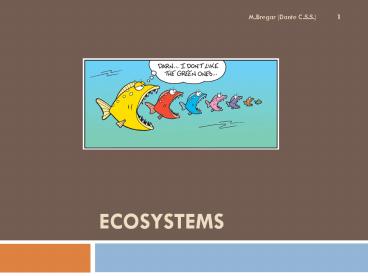Grade 9 - Ecosystems PowerPoint PPT Presentation
Title: Grade 9 - Ecosystems
1
ECOSYSTEMS
2
What is an Ecosystem?
- Definition A complex relationship between the
living organisms, habitats, and resources of a
given area. - Organism are typically dependent on each other
and their habitat for survival. - They can be natural or artificial
3
What is an Ecosystem?
Natural Ecosystem
Artificial Ecosystem
4
What type of ecosystem is this?
5
Monoculture Forest vs Natural Forest
6
Homes and Habitats
- The place where an animal lives is called its
habitat. - An animal lives where it can find food, water,
shelter and a mate.
7
(No Transcript)
8
What is an Ecosystem?
- Ecosystems share similar
- Abiotic Factors temperature, rainfall, etc.
- Biotic factors types of living organisms
- Ecosystems can be large or small, the key idea is
that they share similar factors!
9
(No Transcript)
10
(No Transcript)
11
What is an Ecosystem?
- The largest ecosystems are called biomes.
- There are many biomes, including such as the
Desert, Tundra, Tropical Rainforest, etc.
12
(No Transcript)
13
What is an Ecosystem?
- Living organisms in an ecosystems are
classified into
POPULATIONS
COMMUNITIES
Total individuals belonging to ONE SPECIES in a
habitat
All the combined populations in a habitat
14
Living Things
- All living things (organisms) need food
(nourishment) to live. - Living things in an ecosystem depend on each
other for food.
15
Carnivores
- Some animals, like the kingfisher, eat only other
animals. - These animals are called carnivores.
16
(No Transcript)
17
Carnivores
- Adaptations for killing such as sharp teeth,
claws, strong jaws, binocular vision, and venom. - Ex. carnivores have large canines for tearing
flesh
18
Carnivores
19
Carnivores
- Behavioral adaptations such as stalking pack
hunting
20
Carnivores - Wolves
21
Carnivores - Snakes
22
Herbivores
- Some animals do not eat other animals.
- They survive on plants and are known as
herbivores.
23
(No Transcript)
24
Herbivore
- Adaptations for obtaining and eating plant
material such as specialized teeth, flexible
necks, and strong jaws. - Ex. herbivores have large molars for chewing
plant material
25
- Herbivores have adaptations to avoid being eaten.
26
Omnivores
- Some animals, like us, eat both plants and
animals making them omnivores. - Omnivores have characteristics of both carnivores
and herbivores
27
(No Transcript)
28
(No Transcript)
29
Scavengers
- Animals which consume the carcasses left by
larger predators. - Example crows and vultures
- Move around searching for carrion (dead flesh)
30
Scavengers
- Animals which consume the carcasses left by
larger predators. - Example crows, vultures, hyenas
- Move around searching for carrion (dead flesh) or
any other food sources
31
Scavengers
- Many organisms turn to scavenging as a means of
survival, but they are not true scavengers - Very few animals are true scavengers
32
(No Transcript)
33
Scavengers
- Hyenas have been viewed as scavengers, but they
are also predators.
34
Scavengers
35
Detritivores
- Organisms which eat detritus, such as worms,
beetles, millipedes, etc. - Detritus is dead plant/animal material
- These organisms will move from food source to
food source - Involved in the process of decomposition
36
Decomposers
- Organisms that consume dead or decaying
organisms, this is called decomposition - Decomposers actually live on their food
- Primary decomposers are bacteria and fungi
37
FOOD CHAINS
38
Food Chains
- Diagram showing who eats who within a ecosystem
- Illustrates the flow of organic matter and energy
within an ecosystem. - Arrows represent the flow of energy.
39
Food Chains
- A food chain shows what is eaten.
The fly is eaten by the thrush.
40
Food Chains
The lettuce is eaten by the slug, the slug is
eaten by the bird.
41
Predator
- A predator eats other animals in a food chain
Cats eat fish.
So do bears!
42
Prey
- Any animal which is hunted and killed by another
animal for food is prey.
Predator
Prey
43
Roles in a Food Chain
- Within an ecosystem, organisms have different
roles they take place within a food chain. - The 3 roles are
- (1) Producers,
- (2) Consumers, and
- (3) Decomposers
44
Food Chains
45
All energy comes from the sun
Plants harness the suns energy in which process?
46
Plants need light for photosynthesis, what else
do they need?
We call plants producers because they produce
energy from the sun directly.
47
Photosynthesis
- Photosynthesis the process in which plants make
sugar from sunlight
48
Producers
- Living things which can make their own food from
NON-LIVING THINGS, such as plants or algae - Producers are autotrophs
- Source of all chemical energy in an ecosystem
- They trap sunlight and store it as food energy
(chemical energy)
49
Consumers
- Consume means eat.
- Animals are consumers because they eat
(consume) food provided by plants or other
animals.
50
Consumers
- Living things which must eat other living things
for energy - Consumers are Heterotrophs
- Various types of consumers herbivores,
carnivores, or omnivores
51
Decomposers
- Living things which use waste and dead material
for food - Examples bacteria and fungi
- They are heterotrophs
52
Decomposers
- Help return raw materials and nutrients to the
environment
53
Biodegradation
- This is the recycling of nutrients.
- Completed by decomposers
54
(No Transcript)
55
Producers / Consumers Game
56
Some Key Terms
- Important Key Terms
- AUTOTROPHS organisms which make their own food
from non living things. - HETEROTROPHS organisms which must feed on other
living things for food.
57
Food Chain Game

